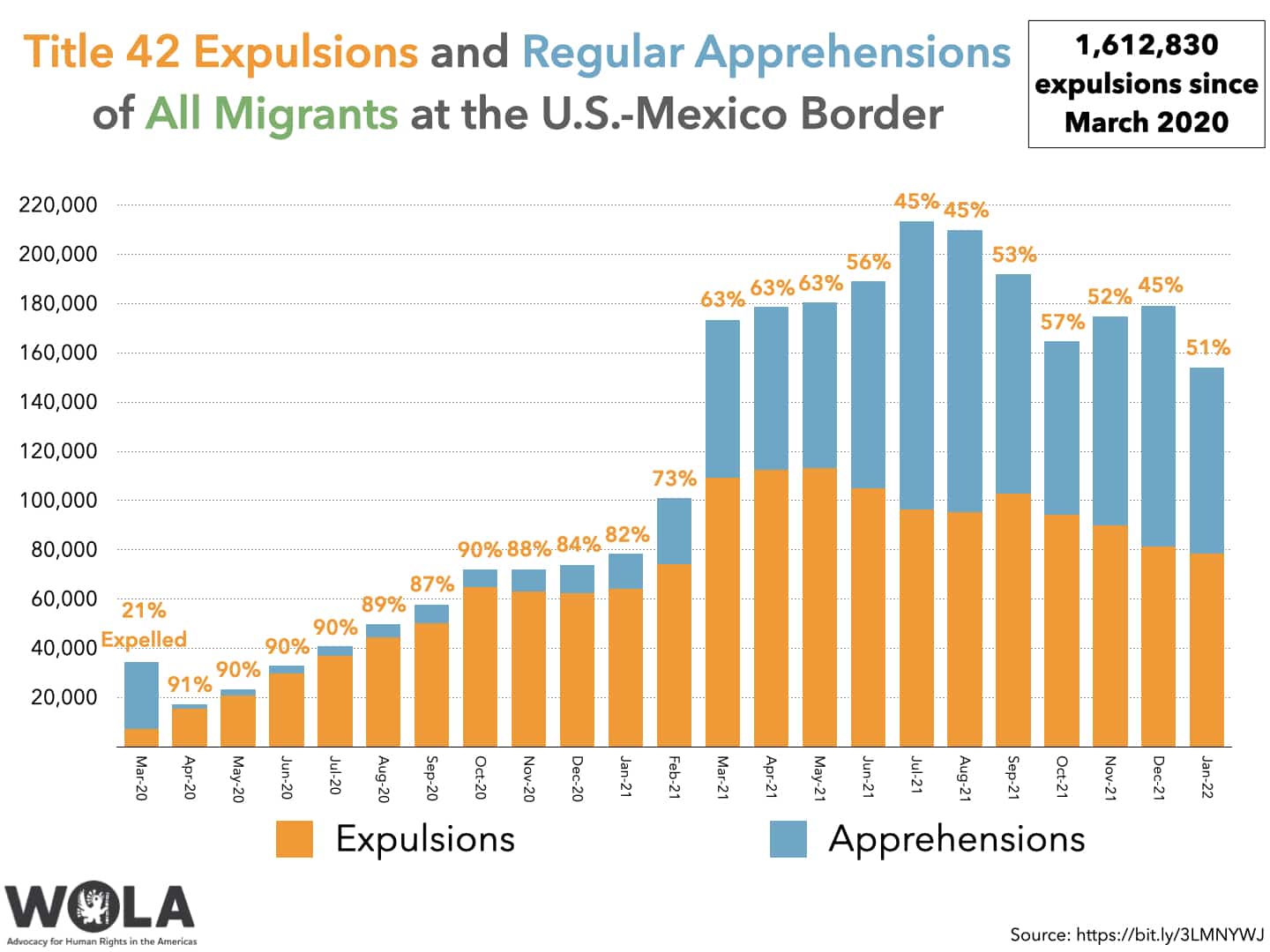With this series of weekly updates, WOLA seeks to cover the most important developments at the U.S.-Mexico border. See past weekly updates here.
Led by sharp “Northern Triangle” reductions, migration declined at the border in January
U.S. Customs and Border Protection (CBP) released data on February 18 (moments after we posted last week’s update) about its January 2022 encounters with undocumented migrants at the U.S.-Mexico border. The agency reported a 14 percent decline in migration from December to January, the first month-to-month drop since October.
The 153,941 migrants encountered was the lowest monthly amount CBP has reported since February 2021. CBP had encountered 26 percent of those migrants at least once in the past 12 months, which means the agency actually took in 111,437 “unique individuals” in January, 18 percent fewer than in December.
The January decline raised some expectations that the jump in migration that greeted the Biden administration in 2021 may be leveling off. The seasonal norm, though, is for migration to jump in spring. Washington Post reporter Nick Miroff, who has seen CBP’s preliminary weekly data, tweeted that migration numbers “have rebounded since mid-Jan. Have remained high in Feb.”
73 percent of January’s migrant encounters were with single adults, a greater proportion than in 2021 (64 percent) and than the average since October (68 percent). This owes to a 26 percent one-month drop in arrivals of unaccompanied children—CBP averaged 295 kids in custody per day, compared to 704 per day in December—and to a 39 percent drop in migrants arriving as families. “Family unit” members totaled just 31,795 in January, down from 86,631 five months earlier, in August.

Arrivals of migrants from Central America’s “Northern Triangle” countries, who had accounted for a large portion of families at the border several months ago, have dropped sharply. 31,414 migrants came from El Salvador, Guatemala, and Honduras in January, down from over 87,000 in August. Only 6,819 family members from those countries came to the border last month, down a remarkable 86 percent from August (50,107 family members).
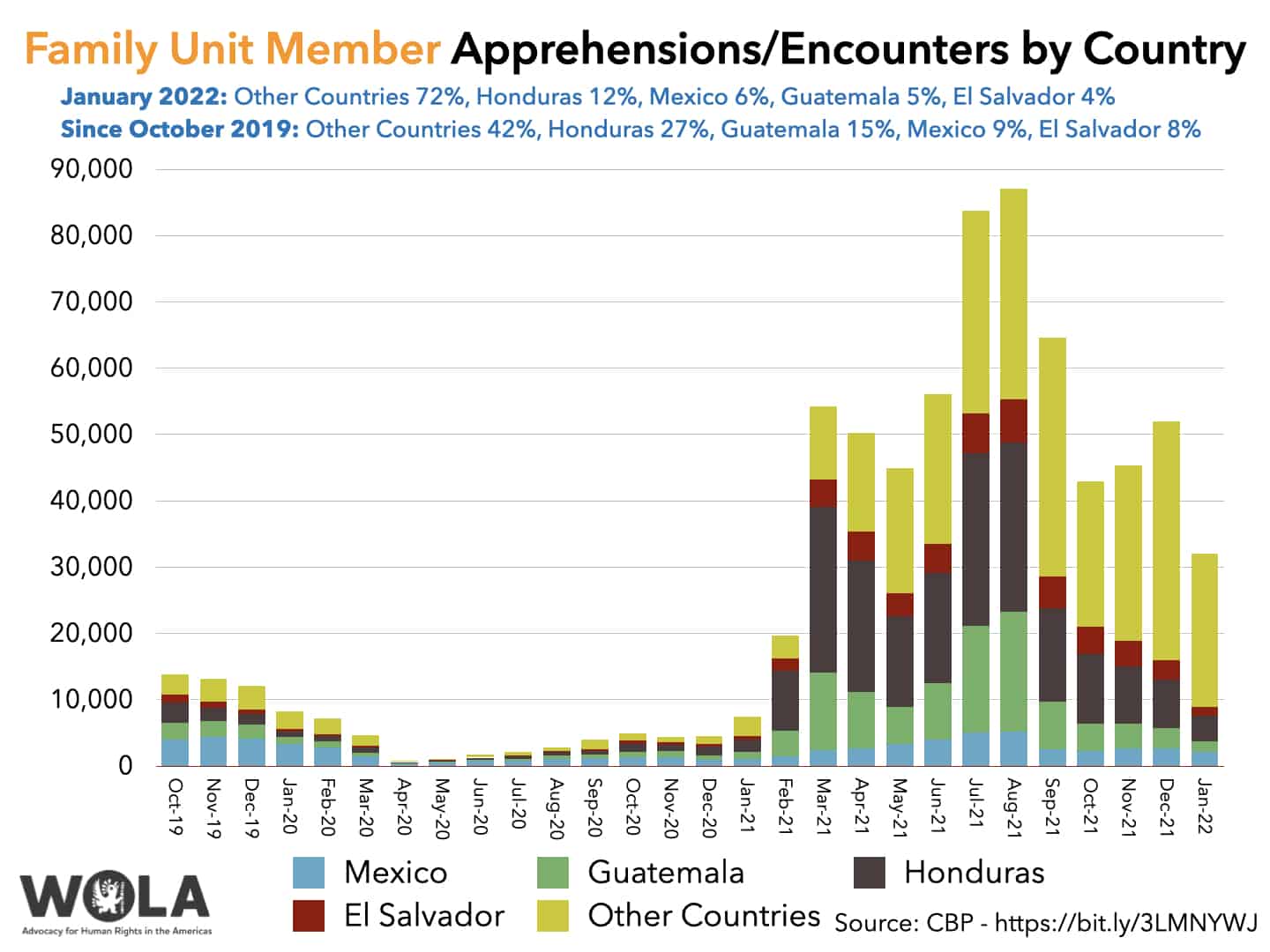
Of those 6,819 Salvadoran, Guatemalan, or Honduran family members, all but 2,130 (69 percent) were expelled under the “Title 42” pandemic authority. Overall, CBP used Title 42 to expel, without an opportunity to request asylum, 51 percent of all encountered migrants in January.
The share of migrants being expelled has been gradually dropping—not because of a renewed Biden administration commitment to asylum, but because migrants are increasingly coming from countries to which expulsion is difficult for reasons of distance or poor diplomatic relations. For the third straight month, Venezuela was the second-largest country of origin of migrants apprehended at the border, a reality that was unprecedented before November 2021. In fact, of all non-expelled migrants in January, a remarkable 58 percent came from Cuba, Nicaragua, and Venezuela, three countries governed by authoritarian regimes with which the U.S. government has very poor relations.
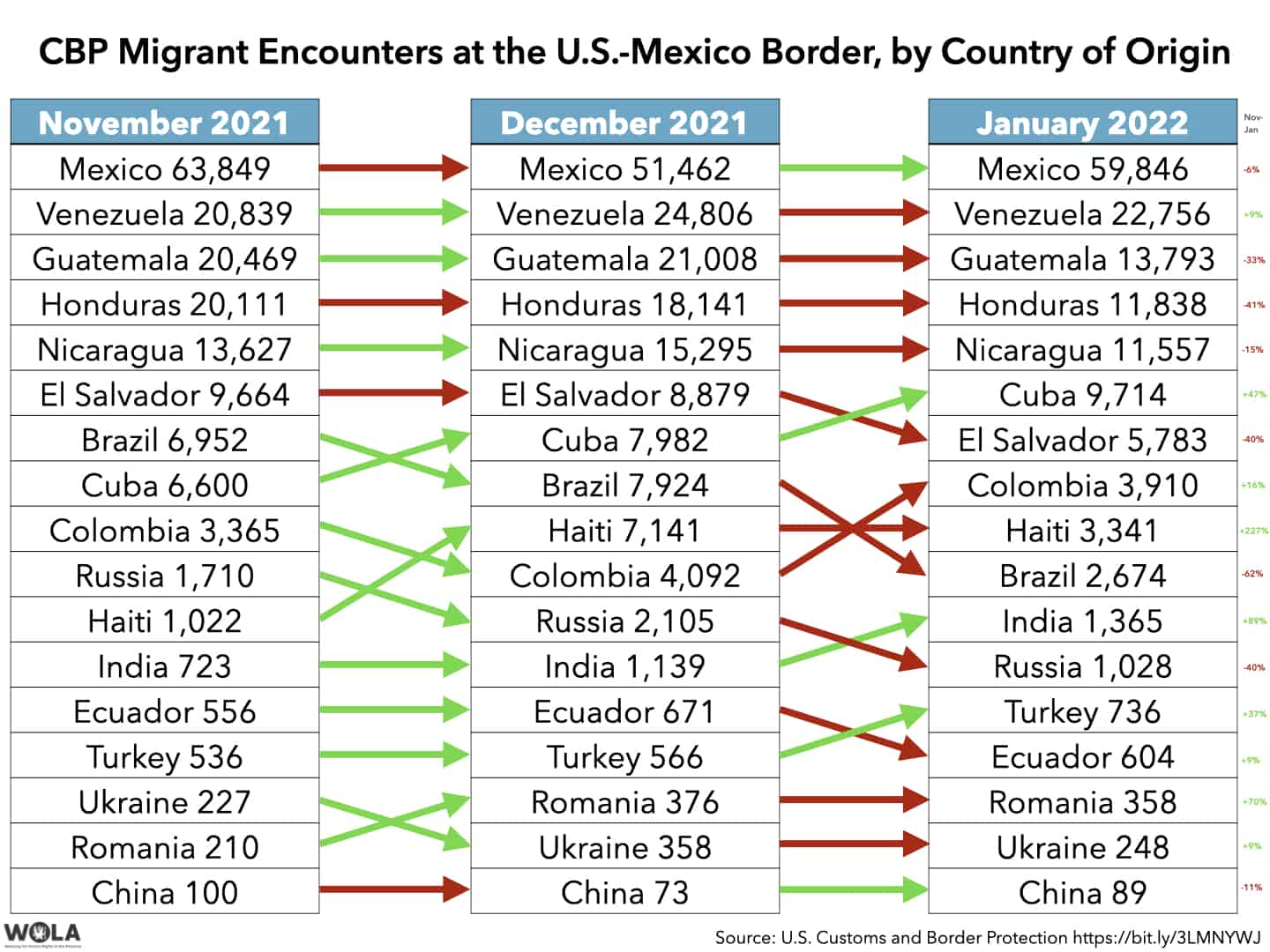
Similar to past months, 97 percent of all migrants expelled under Title 42 came from 5 countries: Mexico, El Salvador, Guatemala, Haiti, and Honduras. Those 5 countries made up 61 percent of all migrants apprehended in January; the other 39 percent came from countries whose citizens rarely have Title 42 applied to them, though last month did see more flights expelling citizens to Brazil.

As in the recent past, this historically high population of non-Mexican, non-“Northern Triangle” migrants is arriving in two rural sectors of the U.S.-Mexico border that were quiet in the 2000s and 2010s: Del Rio, Texas, and Yuma, Arizona/California. Border Patrol divides the U.S.-Mexico border into nine sectors; in January, Del Rio became the number-one sector for CBP migrant encounters. South Texas’s Rio Grande Valley sector, which had held the number one spot since March 2013, fell to number two. Yuma was third.
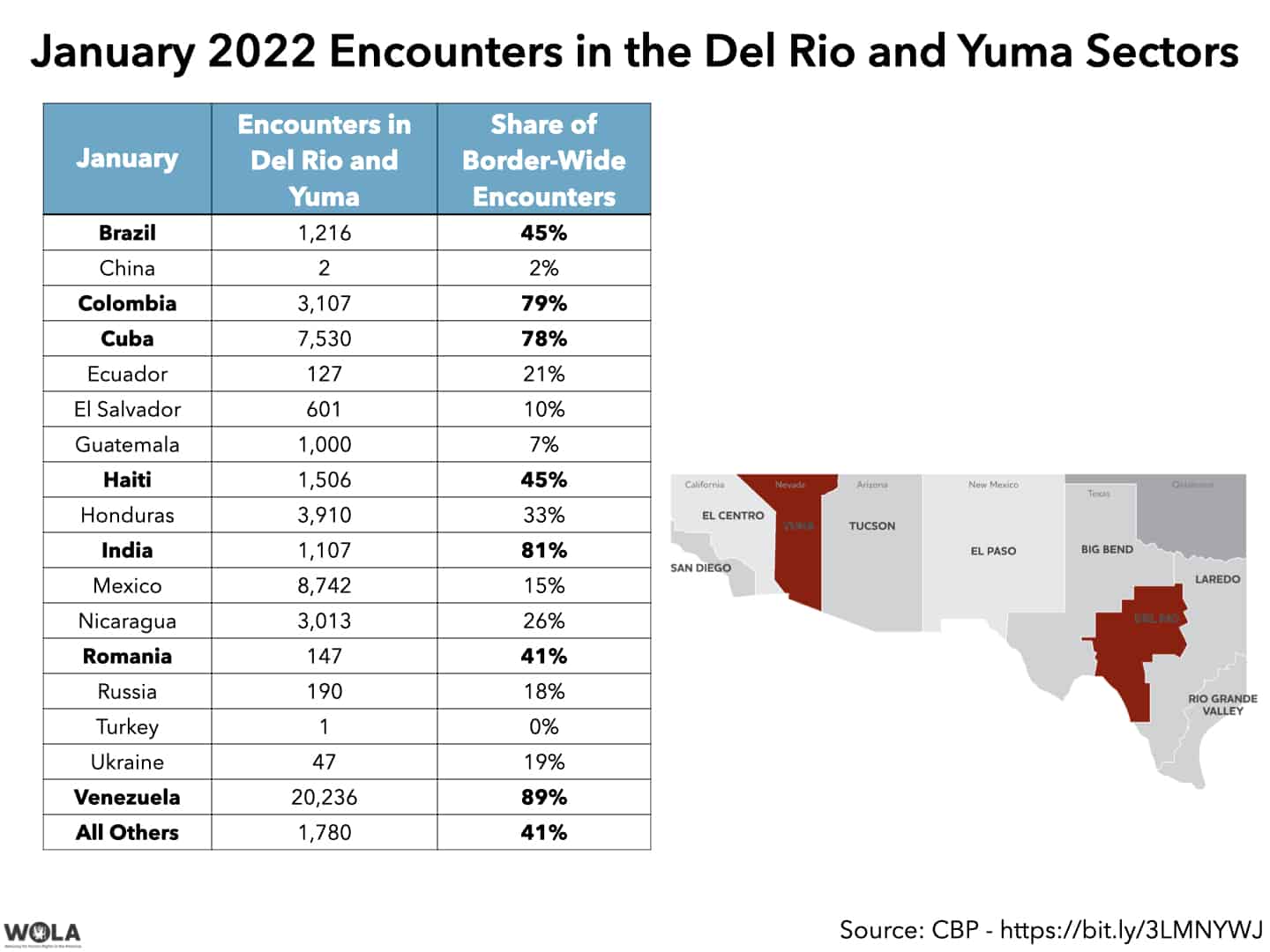
CBP reported month-on-month declines in seizures of most drugs in January (cocaine -69 percent, methamphetamine -45 percent, heroin -85 percent). However, seizures of fentanyl increased 57 percent over an unusually low December. Fentanyl seizures at the border, which almost never reached 300 pounds per month before the pandemic, have, since June 2020, nearly always exceeded 500 pounds, and in some months exceeded 1,000 pounds. During that period, 89 percent of fentanyl seizures have taken place at ports of entry, where CBP’s Office of Field Operations operates—not in the areas in between where Border Patrol operates. In January, 92 percent of fentanyl was seized at ports of entry.
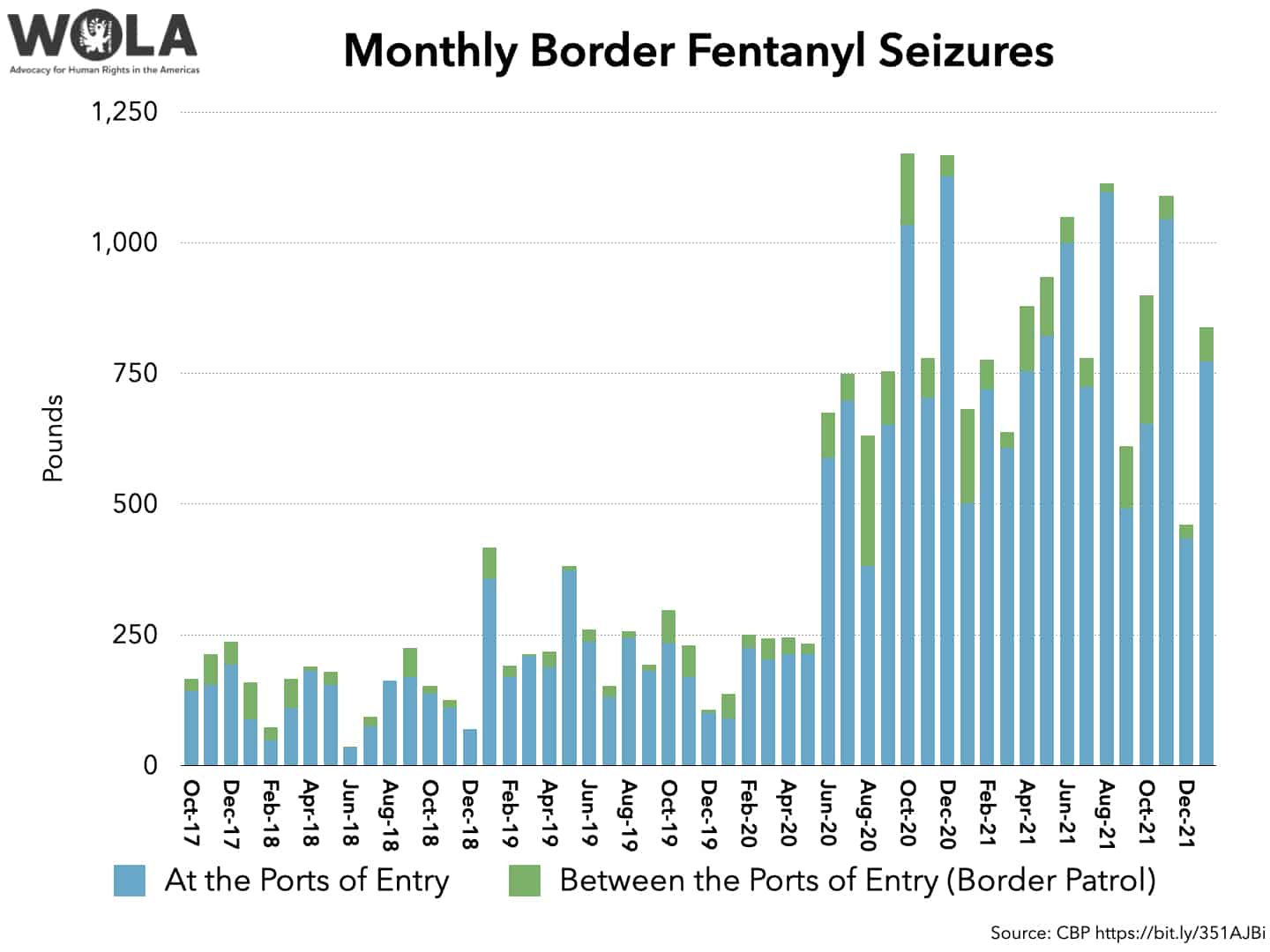
A Mexican citizen dies in an Arizona use of force incident
News reporting datelined February 20 and 21 pointed to Border Patrol personnel shooting a migrant in an incident on the night of February 19, on a desert trail about 30 miles northeast of Douglas, Arizona. In a February 23 statement, CBP confirmed that as two Border Patrol agents were intercepting a group of migrants, one of the agents followed one who attempted to escape and, “while taking him into custody discharged his firearm fatally wounding the migrant, tentatively identified as a citizen of Mexico.”
On the evening of February 24, the Cochise County, Arizona Sheriff’s Department posted a statement conveying the agent’s claims that 32-year-old Carmelo Cruz-Marcos, of Puebla, Mexico, had resisted capture, “then ran approximately six feet away before picking up a large rock and turning back towards the agent making a throwing motion with the hand that held the rock.” The agent then “fired his weapon an unknown number of times as he was in fear for his life and safety.”
The agents requested medical assistance and Cruz-Marcos’s body was airlifted out the next day. The Cochise County Sheriff is investigating the shooting, as is the Pima County (Tucson area) Medical Examiner’s Office. The Medical Examiner determined that Cruz-Marcos died of multiple gunshot wounds. CBP notified the Mexican consulate, which confirmed that the decedent was a Mexican citizen.
CBP reports that its Office of Professional Responsibility (OPR) is also reviewing the incident, as will CBP’s National Use of Force Review Board.
Investigators must determine whether the shooting was truly an act of self-defense or otherwise fell within CBP’s use of force guidelines, which prohibit using firearms “in response to thrown or launched projectiles unless the officer/agent has a reasonable belief, based on the totality of circumstances, that the subject of such force poses an imminent danger of serious bodily injury or death.” If investigators find that the actions violated those guidelines, then the next steps would involve holding personnel administratively and judicially accountable.
“There are multiple red flags in this investigation” so far, a February 23 statement from the Southern Border Communities Coalition (SBCC) contended. It notes that the Cochise County Sheriff’s Office (CCSO) disclosed on February 19 that Border Patrol had killed a migrant, then “removed that statement in subsequent press releases.” SBCC adds:
Instead of the CCSO processing the scene immediately, they waited a day. Even though the other migrants in the area were taken by agents to a Border Patrol station right away, CCSO did not recover the body of the deceased migrant until the following day. The CCSO does not appear to have collected any forensic evidence at all until the next day, including from the agent involved (clothing, fingerprints, ballistics or any other relevant evidence). Instead, they ceded the incident area to border agents who could have tampered with the scene.
SBCC has spearheaded an effort to shed light on Border Patrol’s Critical Incident Teams (BPCITs), secretive units that often arrive quickly at scenes of possible use-of-force violations like this one. The teams allegedly have a record of interfering with investigations and seeking to build narratives that might exonerate the Border Patrol agents involved. While it’s not clear whether a Critical Incident Team is involved in the Arizona incident, SBCC argues, “There can be no independent investigation of border agents with the involvement of the agency that employs them, especially if BPCITs are involved, as they usually are.”
Group documents troubling CBP abuses in El Paso region
The Border Network for Human Rights (BNHR), a 22-year-old grassroots advocacy group based in El Paso, released the latest of a series of “abuse documentation” reports with troubling findings about the behavior of some U.S. border law enforcement personnel, especially CBP officers working at ports of entry.
The BNHR periodically activates its members for “Abuse Documentation Campaigns,” in which trained volunteers posted in “high traffic areas like churches, shopping centers, and international bridges” hold in-person interviews with people who claim to have suffered abuse in their interactions with local and federal law enforcement. The group takes this information as the basis for filing complaints and for what it calls its “El Paso model” of sustained dialogue with local CBP and Border Patrol leadership.
The BNHR’s most recent campaign took place from October 9 to November 9, 2021. Volunteers documented 25 cases that, the organization believes, “reflect the systemic pattern of impunity under which law enforcement agencies interact with border residents.” Sixteen of the twenty-five cases involved abuse by federal border or immigration agencies. Of these, the majority took place at ports of entry: the border bridges between El Paso and Ciudad Juárez, or land crossings between New Mexico and Mexico.
Some of the complaints about Border Patrol allege racial profiling. The most serious allegations, though, involve CBP officers at the ports. BNHR found “a very troubling pattern of body and cavity searches on women,” recounting some painful testimonies. The group notes an “evident pattern” of frequent secondary inspection of border crossers, including many “false positive[s], meaning that there is a practice and potential out-of-policy daily quota to send border residents and citizens of the United States to secondary detention [inspection].” It found examples of verbal and psychological abuse by CBP officers, including insults, intimidation, and threats.
A 71-year-old dual citizen said that a CBP officer pushed him to the floor after he accidentally showed a Mexican identity document instead of his U.S. passport. A woman with DACA status says she was threatened with deportation for being “married to an illegal.” A few women recount having their genitals groped during searches.
The BNHR recommends that CBP’s Office of Field Operations set clear, written limits and standards for secondary inspection at its ports of entry, including limiting the time spent in secondary and its application to vulnerable populations. The report calls for CBP’s Office of Professional Responsibility and the Department of Homeland Security Inspector General to investigate the cases it details. And it calls on the Biden administration to end Title 42 and to “unwind and discontinue” the court-ordered Remain in Mexico policy.
In an email to Border Report about the BNHR findings, a CBP spokesperson responded, “It is important to understand that the agency cannot act upon any perceived issues or allegations unless they are brought to our attention through formal channels.”
Links
- The latest Metering Update from the University of Texas Strauss Center—a resource produced every quarter since June 2018—found its highest-ever number of asylum seekers waiting for an opportunity to present to U.S. border personnel. The report “documents approximately 28,995 asylum seekers on waitlists in eight Mexican border cities. This is an approximately 9 percent increase from November 2021.” Waitlists, a way to determine who gets to approach U.S. ports of entry first, are currently open to new entrants only in Reynosa and Nuevo Laredo, as the Trump and Biden administrations’ Title 42 pandemic restrictions have closed ports of entry to virtually all asylum seekers.
- As of February 22, U.S. authorities had returned 758 asylum-seeking migrants to Mexico under the Remain in Mexico program since the program’s early December court-ordered revival, CBS News’ Camilo Montoya-Galvez tweeted, citing UN migration agency data. Of that total, 386 had been sent from El Paso into Ciudad Juárez, 195 from San Diego to Tijuana, and 177 from Brownsville to Matamoros and Monterrey. The Biden administration, which sought to end the Trump-era Remain in Mexico program, is appealing an August Texas district court ruling mandating the program’s restart. The Supreme Court has agreed to hear arguments in April, Montoya-Galvez reported.
- In Tapachula, Chiapas, near Mexico’s border with Guatemala, members of Mexico’s militarized National Guard clashed with about 100 mostly Cuban, Haitian, and African migrants who allegedly tried to “jump the queue for permits to allow them to continue their journey north.” About 20 people were reported injured. Like many migrant protesters in Tapachula over the past year, they are demanding faster processing of their asylum claims, or at least the ability to leave Tapachula—a city in Chiapas, Mexico’s poorest state—and await their case decisions elsewhere in Mexico. A statement from Mexico’s migration authority (INM) criticized “a contradiction and senselessness in the recent vandalism, because there is no inattention nor can it be a pretext for closing or blocking roads or for threatening with caravans, marches or physical self-harm.”
- Mexico deployed dozens of National Guard troops along the Rio Grande in Ciudad Juárez to prevent migrants from crossing, after about 500 crossed and turned themselves in to U.S. Border Patrol on February 18. Throughout Mexico, the INM reported apprehending 5,020 migrants, including 793 minors, during the week of February 13.
- Chris Magnus, who was sworn in as CBP commissioner in December, faces challenges ranging from “discontent among the ranks” to “persistent allegations that his agency is mistreating migrants, failing to recruit more women and is at the mercy of a broken asylum system,” according to an Associated Press analysis and interview.
- Arizona’s Republican-majority state Senate voted to allocate $700 million to construct “a physical border fence” on state-owned land, or on land agreed with private owners. The state House of Representatives voted for $150 million. As mentioned in our February 11 update’s links, Arizona’s attorney-general and Republican Senate candidate Mark Brnovich issued a legal opinion calling undocumented migration at the border an “invasion” potentially requiring a National Guard response. At the Intercept, Ryan Deveraux looks at the story behind this maneuver.
- President Biden “promised while he campaigned that there would ‘not be another foot,’ but his government has been adding new barriers as it shores up 13 miles of flood levees along the Rio Grande and fixes other segments left in a precarious state by the contractors rushing to build right up to Biden’s inauguration,” writes Nick Miroff at the Washington Post.
- About 250 National Guard soldiers participating in Texas Gov. Greg Abbott’s (R) large “Operation Lone Star” deployment responded to a survey obtained by the Texas Tribune and Military Times. The poll found severe morale problems among the guardsmen who, though considered soldiers, are civilians with regular careers and families when they are not called on to serve. “I’m wasting time watching the grass grow at my [observation] point [along the border], while my civilian job is dying on the vine,” one guardsman said.
- The commander of U.S. Northern Command meanwhile paid a visit to troops deployed to a federal border mission in support of CBP, which Donald Trump launched in 2018 and Joe Biden has continued.
- “Many analysts both on and off the island have interpreted Nicaraguan President Daniel Ortega’s unexpected announcement on November 22, 2021 to authorize free visas to Cuban citizens wishing to travel to Nicaragua as a political favor to Cuba,” an anonymous Cuban author writes at Global Voices. “It is seen as a ploy to lessen the internal pressure Cuba has faced since the protests of July 11, 2021, and to encourage those likely to be involved in new social protests to leave the country.” The writer cites a second objective: “to use Nicaragua as a springboard and generate a new migration crisis for the U.S. on its border with Mexico.” (Just to the south, Costa Rica recently instituted a visa requirement for Cuban citizens, making access to Nicaragua by land more difficult.)
- The New York Times reports that Latino voters in a rural Texas border town are switching party affiliation from Democrat to Republican, due to social conservatism and to “the sharp increase in the number of people crossing the border from Mexico.”

 Adam Isacson
Adam Isacson
